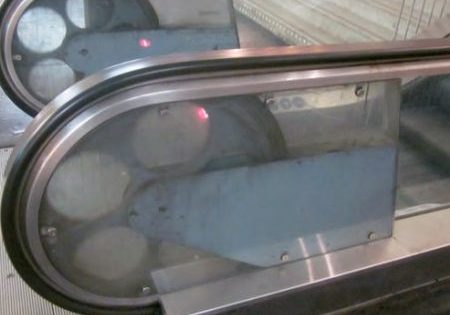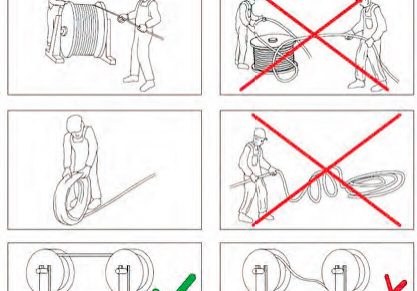In this Readers’ Platform, your author contends that all escalators and inclined moving walks should have an auxiliary brake.
A number of high-profile escalator runaways have happened in recent years, resulting in passenger injuries and deaths. By “runaway,” I mean the uncontrolled rotation of the escalator step band in the down direction. This usually involves excess speed being attained and passengers being unable to egress quickly enough to avoid injury.
Recent escalator runaways include:
- March 26, 2017; Mong Kok Shopping Mall, Hong Kong (17 injuries)
- October 23, 2018; Piazza Della Repubblica, Rome (20 injuries)
The U.K. has not been immune to escalator runaways, with incidents occurring at the Cutty Sark and Reading railway stations. In reality, runaways have been occurring ever since escalators were invented, with some attracting more media attention than others. One of the worst cases occurred at a baseball stadium in the U.S. in 1994. Becoming known as the Camden Yards incident, it resulted in 43 people being injured.
A runaway situation can occur in both upward and downward modes, but the ultimate event results in the escalator rolling backwards (downward) in an uncontrolled manner. Where the escalator was initially traveling in the “up” direction and a runaway occurs, it may be referred to as a “runback” or “unintended reversal.” Where the escalator was running in the downward mode, the unit will simply be in an uncontrolled descent. In either case, the situation may or may not include acceleration of the step band.
In such situations — and especially when an acceleration component is involved — passengers are often deposited in a pile at the bottom end of the escalator due to their inability to egress the escalator because of its high speed. When these events occur, passengers are often seen clambering over the handrail to avoid colliding with others at the bottom of the escalator. In the photograph below, an accumulation of passengers can be seen building up, with passengers behind them unable to avoid those at the bottom as there is no way to escape due to the escalator being installed with a void to the side.
Investigation into such incidents reveals a number of ways a runaway can occur, including a drive chain failure, brake failure or gearbox failure, as indicated in Figure 1.
There have been incidents in which a second component failure also contributed to a runaway situation, primarily when an auxiliary brake is installed but failed to bring the step band to rest. There are other reasons an escalator can runaway, but those illustrated above are the primary ones found in researching the subject. Another reason is a drive unit fixing failure that renders the drive chain, brake and gearbox ineffective, but this appears to have been a one-off event.
Dr. Lufti Al-Sharif previously derived a Venn diagram (Figure 2) showing seven possible ways accidents occur with escalators, with escalator runaways falling into categories including design, maintenance and passenger behavior. Passenger behavior has not been found to be among the primary causes of a runaway. However, it can play a minor role, such as when a passenger presses an emergency stop button that leads to the discovery that the operational brake fails to hold. In addition, it has been found that, in the initial stages of an accelerating runaway, passengers continue to board the escalator if it is a downward-running machine, unaware that it is in trouble.
This leads to the other two components: namely, design and maintenance. When it comes to design, the inclusion of an auxiliary brake is a consideration. Not all escalators require an auxiliary brake which, in my opinion, needs thinking through.
Consideration should also be given to the location of the operational brake since, if it is onboard the gearbox, it will provide no protection in the event of a gearbox internal failure. This is the same for geared-machine lifts where the brake is typically between the hoist motor and gearbox.
Maintenance is normally a key contender in escalator runaway situations, especially with respect to brake failures in which issues such as lubrication getting onto braking surfaces, poor adjustment or worn pads can be contributory factors. One should also remember that the brake is often used as a means to stop an escalator at the end of a working day. Therefore, even if a variable-frequency drive is fitted, the pads are subject to wear on a regular basis.
In the incident in Rome, it appears that someone activated an emergency stop button, expecting the operational brake to bring the escalator to a safe stop and hold the step band in position. The operational brake, however, failed to do so. It appears the step band started to accelerate in the down direction, causing passenger overcrowding. In the environment where the escalator was installed, it would be expected that an auxiliary brake would have been installed, and on that assumption it clearly failed to arrest reversal of the step band.
In the photograph below, passengers are shown during the initial phase of a runaway. One passenger can be seen holding onto the passenger in front of them.
The 2017 EN115 standard (5.4.2.2) more-or-less mirrors the previous 2008 and 1995 standards with respect to requiring an auxiliary brake and states:
Escalators and inclined moving walkways shall be equipped with auxiliary brake(s) if:
a) the connection between the operational brake and the driving sprockets of the steps/pallets or the drum of the belt is not accomplished by shafts, gear wheels, multiplex chains, or more than one single chain, or
b) the operational brake lacks an electrical-mechanical brake according to 5.4.2.1.2, or
c) the rise exceeds 6 m.
The problem with this situation is that an escalator or inclined moving walk with a rise of less than 6 m with a conformant drive chain can still fail and runaway due to brake failure, gearbox failure or drive chain failure.
The 2017 EN115 standard (Clause 5.12.2.7.3) also calls for detection of unintentional reversal of direction of travel and states, “A device shall be provided for escalators and inclined (α = ≥6°) moving walks to detect the unintentional reversal of direction of travel.” The problem with this is that it could use the operational or auxiliary brake (if fitted) to prevent the reversal, and these components have been known to fail. 5.12.2.7.2 also calls for the detection of excessive speed before the speed exceeds a value of 1.2 times the nominal speed.
It can be argued that the standards provide sufficient protection. However, it is your author’s contention that an auxiliary brake should be provided on all escalators and inclined moving walks in situations where the failure of the operational brake, gearbox and/or drive chain can occur. In reality, this would mean that all escalators and inclined moving walks would require an auxiliary brake.
Get more of Elevator World. Sign up for our free e-newsletter.










